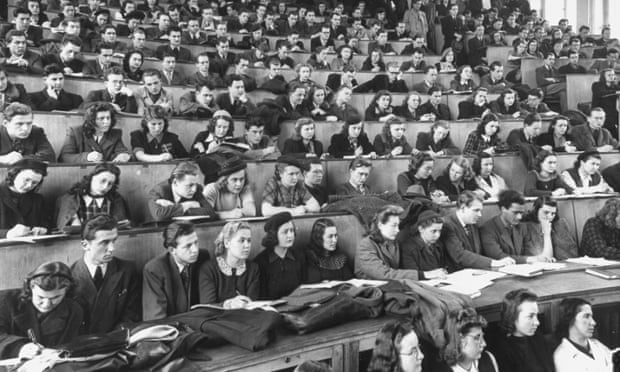Are lectures the best way to teach students?
University lectures are often slated for being boring and poorly
attended, but is scrapping them a good idea? Academics debate the matter

‘It is sad that so few modern students will ever experience a real lecture’
Bruce Charlton, reader in evolutionary psychiatry, Newcastle University, says:
Real lectures are always greatly appreciated by students who want to
learn. But what are called “lectures” nowadays are a travesty.
Vast, stuffy venues that seat hundreds; students sitting in the dark
and unable to see the speaker; a disembodied voice droning into a
microphone; the lecturer reading out endless powerpoint slides which
have already been posted online; the scanty audience passive instead of
actively making their own notes – distracted by themselves and others
intermittently browsing the internet and social networks; and the whole
thing being recorded as if to emphasise to students that they don’t
really need to be there nor pay attention.
These atrocities are what people currently call lectures, and they are indefensible.
But the alternatives to lectures are mere gimmicks and novelties designed to get praise and awards for teaching “innovation”. (A bicycle with triangular wheels is an innovation – the proper question is whether it is fit for purpose.)
These atrocities are what people currently call lectures, and they are indefensible.
But the alternatives to lectures are mere gimmicks and novelties designed to get praise and awards for teaching “innovation”. (A bicycle with triangular wheels is an innovation – the proper question is whether it is fit for purpose.)
When lectures are taken seriously, and conducted in the proper way,
they are the best pragmatic way of teaching knowledge to people who want
to know.
Good lectures are possible and achievable – I experienced many of them at my medical school. But they are not easy, nor are they as cheap as some alternatives. Good lectures require all-round effort from people who appoint teaching staff and design lecture theatres; from those who construct courses and those who create the educational ethos.
And (hardest of all) good lectures require here-and-now concentration during the actual teaching period – effort from both lecturer and audience alike. A good lecture is hard work because it’s a one-off performance. Like the theatre rather than the cinema, everybody present contributes to the success or failure, everybody is involved. But when it works, it’s an experience that may be remembered forever.
Real lecturing is irreplaceable in the same way that live theatre or musical performance is irreplaceable – seeing and hearing each other in real-time and working together on something they both value.
It is sad that so few modern students will ever experience anything of this kind.
Good lectures are possible and achievable – I experienced many of them at my medical school. But they are not easy, nor are they as cheap as some alternatives. Good lectures require all-round effort from people who appoint teaching staff and design lecture theatres; from those who construct courses and those who create the educational ethos.
And (hardest of all) good lectures require here-and-now concentration during the actual teaching period – effort from both lecturer and audience alike. A good lecture is hard work because it’s a one-off performance. Like the theatre rather than the cinema, everybody present contributes to the success or failure, everybody is involved. But when it works, it’s an experience that may be remembered forever.
Real lecturing is irreplaceable in the same way that live theatre or musical performance is irreplaceable – seeing and hearing each other in real-time and working together on something they both value.
It is sad that so few modern students will ever experience anything of this kind.

‘There are a myriad of reasons – lapses in concentration or early starts, for example – why students don’t get as much out of lectures’
University teacher Sam Marsh, and senior lecturer Nick Gurski, in
the school of mathematics and statistics at the University of
Sheffield, say:
Well-delivered lectures can be a good way of passing on
knowledge and they dominate teaching in higher education. But there are a
myriad of reasons, lapses in concentration or early starts, for
example, why students might not get as much from them as we’d hope – and
these issues are amplified by large cohorts.
We were faced with stubborn attendance problems on our large
first-year modules. Classes often ended the semester half-empty. We’d
tried our most popular lecturers, updated the course materials and
introduced online tests with little effect.
We decided to create a collection of specially-filmed short videos to
replace lectures on a module teaching mathematics to engineers.
Students
would watch the videos online in their own time and each would be
followed by a short quiz. By changing the character of weekly problem
classes to include more demonstration and peer discussion we could
double their frequency without a big increase in staff time. This would
be where students would really benefit from interaction with both
lecturers and other students.
When the pilot launched we quickly noticed that not only did students
watch the vast majority of the videos on time, but attendance improved
dramatically. Over the year students attended three times as many
problem classes as traditionally-taught peers from other departments.
When we applied statistical analysis to three years’ worth of exam
data, comparing with other cohorts on the same syllabus, we found that
we had added somewhere between 4 and 12 marks to the average grade of a
student.
Our format is now expanding across the engineering faculty, and next year we will teach 1,000 students in this way.
There may, of course, be a limit to how many videos students can watch in a week. In some cases the time-honoured lecture format is working very nicely. But it seems clear to us that there are lots ways to teach, and some of the best don’t involve lectures.

Um comentário:
[ Comentário em FACDEVMEDED por Steve Davis ]
A condensed summary from the Journal of the International Association of Medical Science Educators (JIAMSE) Volume 19 Number 3 2009 on the article “Student Perspectives on the Value of Lectures:”
Some of the conclusions to emphasize why lectures can still be very effective if done well; Lectures:
v provide focus and emphasis
v reinforces learning through multimodality exposure
v explain/resolve difficulties and complexities in the notes and other readings
v provide an overview, “the big picture”
v provide exposure to experts/role models
v are a time-efficient way to learn
v encourage structure and discipline
v provide depth and insight through examples not present in the readings
v perpetuate a habitual/traditional way of learning – soothe anxiety
v provide a dynamic, interesting way to learn
· Many students regard the lecture method as a valuable multifaceted aid to learning
· The most frequently stated characteristics of a good lecturer were animation, enthusiasm, passion, and clarity/organization (See: Quick Lesson Plan Template for clarity and organization)
· A dominant theme emerging from the qualitative survey is the rather obvious point that the utility of a lecture depends heavily upon the quality of the lecturer (practice and get feedback! See Classroom Observation Form)
NOTE FROM STEVE: The best lecturers I’ve experienced are actually a combination of the sage and the guide. If you lecture, and I assume everyone does, become of student of mastering that very learnable skill. Watch others, note what works, videotape yourself and review (painful but very valuable), ask for feedback using a feedback tool, select a few “great lecturing” articles from the internet and try to incorporate the best practices, read William Safire’s “Lend Me Your Ears: Great Speeches in History” – at least the intro.
Postar um comentário